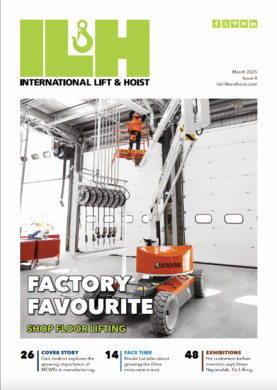)
Renewed energy
Ross Moloney, CEO at the Lifting Equipment Engineers Association (LEEA), discusses a fascinating presentation on the energy the landscape and the opportunities that new projects are creating for the Lifting Industry.
Energy security is high on everyone’s agenda and is set to be so for some time to come, with disrupted supplies due to the war in Ukraine causing prices to soar at a time when, critically, many markets are making a transition to greater sustainability. The energy sector’s constituent markets are key for LEEA and for many of those working in the lifting industry. They are naturally impacted by the economic ups and downs.
But as Neil Golding, director of Market Intelligence – Energy Industry Council, has pointed out there are exciting opportunities in the energy sector for our industry. Neil’s presentation, made during LEEA’s GLAD series of online seminars, is a fascinating watch and I encourage you to view it, if you haven’t already, here: https://leeaint.com/open-learning.
In terms of the more mature part of the energy landscape, oil and gas projects previously put on hold are coming live again. There could be investment of up to 4.34 trillion dollars – between now and 2027 in the mature hydrogen carbons and mature power markets. The critical role that nuclear has in the energy mix is being recognised, though these projects have longer lead times.
Where Neil sees see significant growth and potential opportunities for many of those in the lifting sector will be small modular nuclear reactors. Although development is in its infancy, these 350-500 megawatt reactors will have a modular design that could feature some 3000 separate modules, all built in factories and then transported to site for assembly. This is creating exciting opportunities in the UK, where this development is about to see significant growth, though it is small compared to Canada, which expects to see 200 small modular reactors constructed. No doubt other countries will follow.
Renewables will of course continue to increase. They represent a sizeable 32% on investments in projects due to be commissioned by 2027. Growth in offshore wind is huge. From 2022 and beyond, we could see upwards of 588GW of new capacity installed by 2030, should projects proceed, requiring $1.5 trillion of global capex. Major energy companies are making a move into the sector, driving local supply, as the challenge being set is for supporting supply chains to deliver these projects.
Following a big jump between 2024 and 2025, which will see a tripling in the number of turbines becoming operational, there will be a steady wave of turbines being installed before peaking again in 2030. Large turbine sizes and capacities up to 20MW are expected – again setting challenges for the supporting supply chain. Here are more opportunities for the lifting sector. And this is in addition to those coming from decommissioning or repairing wind farms installed in the 2000s, which are approaching the end of their operational life.
Supply chains will also need to support the hydrogen strategies that are continuing to be announced. This area shows the biggest growth, along with energy storage, in the energy transition sector, driven by the increasing demand for clean fuels. Some markets are looking at hydrogen for domestic needs while others, such as the UK, are looking at the export market. New players, other than the traditional energy companies, are joining in but again there is the need to consider infrastructure to handle hydrogen, such as terminals, but there is plenty of activity in this sector, racking up further good news for the supporting supply chain.
Carbon capture is the key technology for industry as it strives for decarbonisation but it requires government policy, financial support and, most significantly, business models need to be finalised for operators to make the step to final investment. Better collaboration and a set of global standards will be required to deliver what will be complex projects, but there are synergies with existing supply chains.
Clearly, among the hard realities of global energy markets at the moment there are many large and very exciting opportunities for the supporting supply chain, which must ready itself to deliver on these projects for the future. That is a call to action to LEEA members and the lifting industry.











